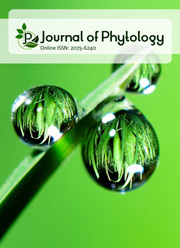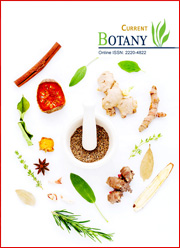Morphological characterization of maize (Zea mays L.) genotypes for drought tolerance
DOI:
https://doi.org/10.25081/jp.2025.v17.9385Keywords:
Maize (Zea mays L.), Drought, Heritability, Genetic diversity, YieldAbstract
Drought stress poses a major challenge to global maize (Zea mays L.) production, significantly affecting food security. This study aimed to identify drought-tolerant maize genotypes by evaluating their morphological characteristics under controlled and field conditions. Morphological traits, such as shoot and root length in the seedling stage and plant height, canopy temperature, ear length, and kernel weight at vegetative and reproductive stages, were analyzed under drought stress conditions induced by PEG and reduced field capacity. Significant genetic variability was observed among the genotypes for most traits, with phenotypic coefficient of variation (PCV) consistently higher than genotypic coefficient of variation (GCV). Heritability estimates ranged from 37% to 99.82%, with traits such as plant height, kernel weight per ear, ear weight, hundred-seed weight, and yield per pot demonstrating both high heritability and genetic advance. Yield showed positive correlations with plant height, ear length, ear diameter, kernel number per row, and kernel weight per ear, while negatively correlating with days to ear moisture loss. Principal Component Analysis (PCA) revealed that the first five components explained 83.46% of the total variation, with yield-related traits contributing most to the variation. Cluster analysis revealed eight distinct groups at the seedling stage and six at the vegetative and reproductive stages, with genotypes in Clusters 5 and 6 exhibiting superior drought tolerance, particularly in traits like root number, kernel number per ear, and kernel weight per ear. This study identified BHM-7, BHM-14, and BHM-15 as genotypes with superior drought tolerance at the reproductive stage, while Black, Violet, and White Vutta showed resilience at the seedling stage, exhibiting greater plant vigor under drought stress. Recognizing these genotypes as a significant step toward breeding drought-resistant maize varieties, contributing to food security and sustainable agriculture.
Downloads
References
Ahmad, W., Bibi, N., Sanwal, M., Ahmed, R., Jamil, M., Kalsoom, R., Arif, M., & Fahad, S. (2024). Cereal crops in the era of climate change: An overview. In S. Fahad, S. Saud, T. Nawaz, L. Gu, M. Ahmad & R. Zhou (Eds.), Environment, climate, plant and vegetation growth (pp. 609-630) Cham, Switzerland: Springer. https://doi.org/10.1007/978-3-031-69417-2_21
Akanda, M. A. L., Alam, M. S., & Uddin, M. M. (1997). Genetic variability, correlation, and path analysis in maize (Zea mays L.) inbreds. Bangladesh Journal of Plant Breeding and Genetics, 10, 57-61.
Akinwale, R. O., Awosanmi, F. E., Ogunniyi, O. O., & Fadoju, A. O. (2018). Determinants of drought tolerance at the seedling stage in early and extra-early maize hybrids. Maydica, 62, 1-9.
Akter, A., Hasan, M. J., Paul, A. K., Mutlib, M. M., & Hossain, M. K. (2009). Selection of parent for improvement of restorer line in rice (Oryza sativa L.). SAARC Journal of Agriculture, 7(2), 43-50.
Allard, R. W. (1960). Principles of plant breeding. New york, US: John Wiley & Sons, Inc.
Al-Naggar, A. M. M., Shafik, M. M., Musa, R. Y. M., Younis, A. S. M., & Anany, A. H. (2020). Genetic variability of maize hybrids and populations and interrelationships among grain yield and its related traits under drought and low N using multivariate analysis. Asian Journal of Biochemistry, Genetics and Molecular Biology, 4(2), 26-44. https://doi.org/10.9734/ajbgmb/2020/v4i230102
Aslam, M., Zamir, M. S. I., Afzal, I., Yaseen, M., Mubeen, M., & Shoaib, A. (2013). Drought stress: Its effect on maize production and development of drought tolerance through potassium application. Cercetări Agronomice în Moldova, 46(2), 99-144.
BBS. (2022). Yearbook of agricultural statistics 2022. Bangladesh Bureau of Statistics. Ministry of Planning, Government of the People's Republic of Bangladesh.
Bello, O. B., Abdulmaliq, S. Y., Afolabi, M. S., & Ige, S. A. (2010). Correlation and path coefficient analysis of yield and agronomic characters among open-pollinated maize varieties and their F1 hybrids in a diallel cross. African Journal of Biotechnology, 9(18), 2633-2639.
Burton, G. W. (1952). Quantitative inheritance in grasses. Proceedings of 6th International Grassland Congress, 1, 277-283.
Choudhary, M. L., Tripathi, M. K., Tiwari, S., Pandya, R. K., Gupta, N., Tripathi, N., & Parihar, P. (2021). Screening of pearl millet [Pennisetum glaucum (L.) R. Br.] germplasm lines for drought tolerance based on morpho-physiological traits and SSR markers. Current Journal of Applied Science and Technology, 40(5), 46-63. https://doi.org/10.9734/cjast/2021/v40i531303
Clark, G. M. (1973). Statistics and experimental design. London, UK: Edward Arnold.
Comstock, R. E., & Robinson, H. F. (1952). Genetic parameters, their estimate and significance. Proceedings of 6th International Grassland Congress, 1, 284-291.
Daryanto, S., Wang, L., Jacinthe, P.-A. (2016). Global synthesis of drought effects on maize and wheat production. Plos One, 11(5), e0156362. https://doi.org/10.1371/journal.pone.0156362
Farshadfar, E., Romena, H., & Shabani, A. (2013). Evaluation of genetic parameters in agrophysiological traits of wheat (Triticum aestivum L.) under irrigated conditions. International Journal of Advanced Biological and Biomedical Research, 1(4), 331-340.
Gazal, A., Nehvi, F. A., Lone, A. A., & Dar, Z. A. (2018). Morphological and molecular characterization of maize inbred lines showing variability for drought tolerance. Genetics and Molecular Research, 17(2), gmr16039903.
Gupta, A., Rico-Medina, A., & Cano-Delgado, A. I. (2020). The physiology of plant responses to drought. Science, 368(6488), 266-269. https://doi.org/10.1126/science.aaz7614
Hall, A. J., Lemcoff, J. H., & Trapani, N. (1981). Water stress before and during flowering in maize and its effects on yield, its components, and their determinants. Maydica, 26, 19-38.
Hanson, C. H., Robinson, H. F., & Comstock, R. E. (1956). Biometrical studies on yield in segregating populations of Korean Lespedeza. Agronomy Journal, 48(6), 268-274. https://doi.org/10.2134/agronj1956.00021962004800060008x
Holland, S. M. (2008). Principal components analysis (PCA). Department of Geology, University of Georgia, Athens, GA.
Ilyas, M., Khan, S. A., Awan, S. I., & Shafiq-Ur-Rehman (2019). Assessment of heritability and genetic advance in maize (Zea mays L.) under natural and water stress conditions. Sarhad Journal of Agriculture, 35(1), 144-154. https://doi.org/10.17582/journal.sja/2019/35.1.144.154
Jia, H., Li, M., Li, W., Liu, L., Jian, Y., Yang, Z., Shen, X., Ning, Q., Du, Y., Zhao, R., Jackson, D., Yang, X., & Zhang, Z. (2020). A serine/threonine protein kinase encoding gene kernel number per row6 regulates maize grain yield. Nature Communications, 11, 988. https://doi.org/10.1038/s41467-020-14746-7
Johnson, H. W., Robinson, H. F., & Comstock, R. E. (1955). Estimates of genetic and environmental variability in soybeans. Agronomy Journal, 47(7), 314-318. https://doi.org/10.2134/agronj1955.00021962004700070009x
Kondwakwenda, A., Sibiya, J., Zengeni, R., & Musvosvi, C. (2021). Aspects in breeding maize for drought tolerance: Progress and modern breeding approaches. Australian Journal of Crop Science, 15(4), 510-517.
Makumbi, D. (2015). Phenotypic and genotypic characterization of white maize inbreds, hybrids, and synthetics under stress and non-stress environments. Makerere University.
Maqbool, S., Amna, A., Maqbool, A., Mehmood, S., Suhaib, M., Sultan, T., Munis, M. F. H., Rehman, S., & Chaudhary, H. J. (2021). Interaction of ACC deaminase and antioxidant enzymes to induce drought tolerance in Enterobacter cloacae 2WC2 inoculated maize genotypes. Pakistan Journal of Botany, 53. https://doi.org/10.30848/PJB2021-3(28)
Marker, S., & Krupakar, A. (2009). Genetic diversity in exotic maize germplasm (Zea mays L.). ARPN Journal of Agricultural and Biological Science, 4(4), 44-47.
Miller, P. A., William, J. C., Robinson, H. F., & Comstock, R. E. (1958). Estimates of genotypic and environmental variances and covariance in upland cotton and their implication in selection. Agronomy Journal, 50(3), 126-131. https://doi.org/10.2134/agronj1958.00021962005000030004x
Mohanapriya, B., Ravikesavan, R., Senthil, N., Iyanar, K., Senthil, A., & Sheela, K. R. V. S. (2023). Genetic variation and trait association of maize hybrids under irrigated and drought-stress environments. Electronic Journal of Plant Breeding, 13(4), 1343-1353. https://doi.org/10.37992/2022.1304.178
Monneveux, P., Sanchez, C., & Tiessen, A. (2008). Future progress in drought tolerance in maize needs new secondary traits and cross combinations. The Journal of Agricultural Science, 146(3), 287-300. https://doi.org/10.1017/S0021859608007818
Moss, G. I., & Downey, L. A. (1971). Influence of drought stress on female gametophyte development in corn (Zea mays L.) and subsequent grain yield. Crop Science, 11(3), 368-373. https://doi.org/10.2135/cropsci1971.0011183X001100030017x
Pandit, M., Chakraborty, M., Haider, Z. A., Pande, A., Sah, R. P., & Sourav, K. (2016). Genetic diversity assay of maize (Zea mays L.) inbreds based on morphometric traits and SSR markers. African Journal of Agricultural Research, 11(24), 2118-2128. https://doi.org/10.5897/AJAR2015.10404
Saif-ul-Malook, Ahsan, M., Ali, Q., & Mumtaz, A. (2014). Inheritance of yield-related traits in maize (Zea mays) under normal and drought conditions. Natural Science, 12(9), 36-49.
Salami, A. E., Adegoke, S. A. O., & Adegbite, O. A. (2007). Genetic variability among maize cultivars grown in Ekiti-State, Nigeria. Middle-East Journal of Science and Research, 2(1), 09-13.
Shahzad, A., Gul, H., Ahsan, M., Wang, D., & Fahad, S. (2023). Comparative genetic evaluation of maize inbred lines at seedling and maturity stages under drought stress. Journal of Plant Growth Regulation, 42, 989-1005. https://doi.org/10.1007/s00344-022-10608-2
Shaw, R. H. (1988). Climate requirement. In G. F. Sprague & J. W. Dudley (Eds.), Corn and corn production (Vol. 18) New York, US: John Wiley & Sons, Inc. https://doi.org/10.2134/agronmonogr18.3ed.c10
Singh, B. P., Lenka, D., Lenka, D., & Tripathy, S. K. (2020). Physiological characterization of maize inbred lines under moisture deficit condition. Journal of Pharmacognosy and Phytochemistry, 9(1), 112-114.
Singh, R. K., & Chaudhary, B. D. (1985). Biometrical methods in quantitative genetic analysis. Tamil Nadu: India: Kalyani Publication.
Snedecor, G. W., & Cochran, W. (1967). Statistical methods. Ames, Iowa: Iowa State University Digital Press.
Suryanarayana, L., Sekhar, M. R., Babu, D. R., Ramana, A. V., & Rao, V. S. (2017). Cluster and principal component analysis in maize. International Journal of Current Microbiology and Applied Sciences, 6(7), 354-359. https://doi.org/10.20546/ijcmas.2017.607.042
Wang, X., Xu, Y., Hu, Z., & Xu, C. (2018). Genomic selection methods for crop improvement: Current status and prospects. The Crop Journal, 6(4), 330-340. https://doi.org/10.1016/j.cj.2018.03.001
Zarei, B., Kahrizi, D., Aboughadareh, A.-P., & Sadeghi, F. (2012). Correlation and path coefficient analysis for determining interrelationships among grain yield and related characters in corn hybrids (Zea mays L.). International Journal of Agriculture and Crop Sciences, 20, 1519-1522.
Published
How to Cite
Issue
Section
Copyright (c) 2025 Fariha Tasnim, Md. Sultan Ahmed, Md. Arifur Rahaman, G. H. M. Sagor

This work is licensed under a Creative Commons Attribution 4.0 International License.





 .
.